KTCU Host Interviewed Celebrities like Bob Hope, Don Knotts
Barto Farrar brought bandleaders, country stars and even a Nobel-winning scientist to the KTCU airwaves.
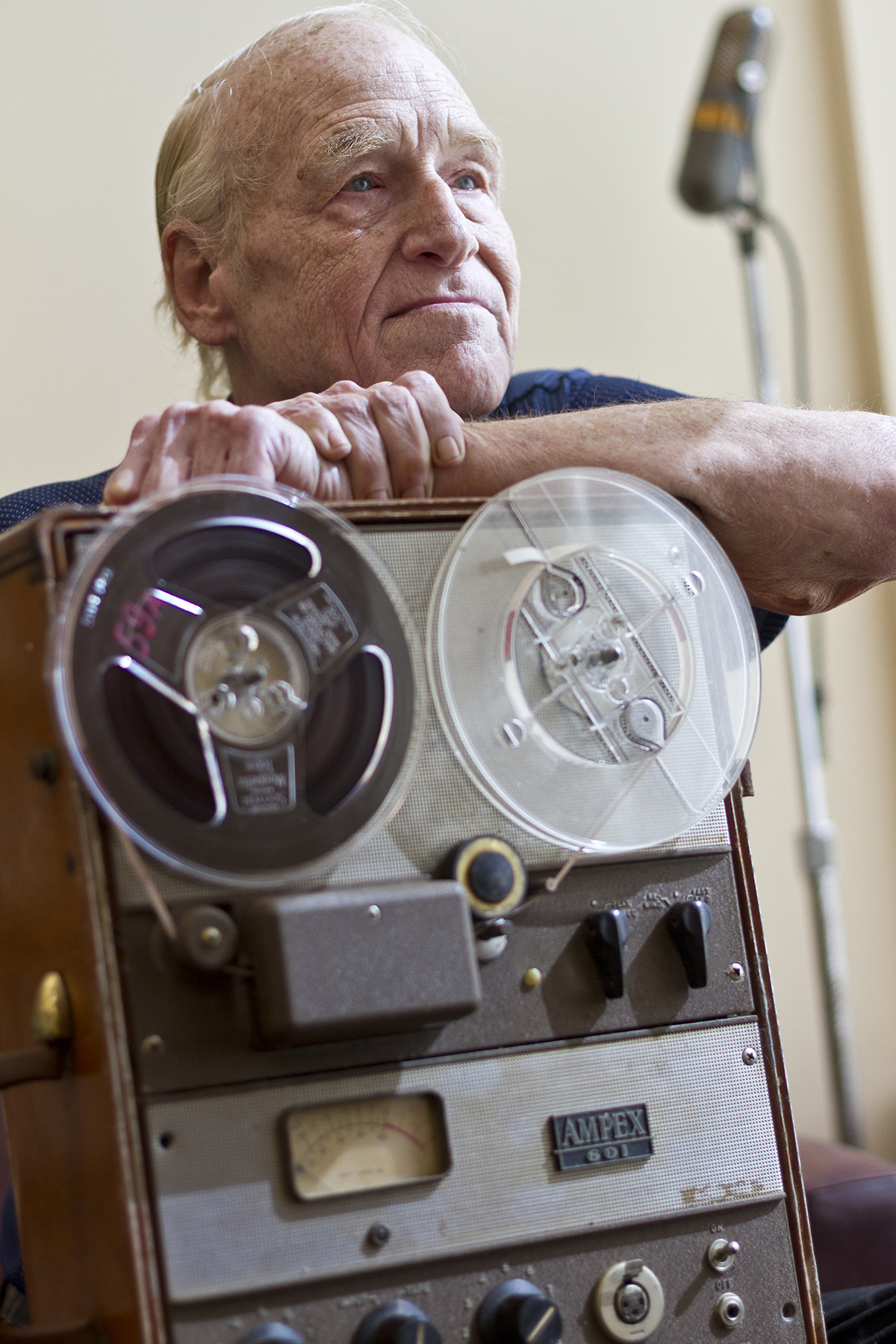
TCU alum Barto Farrar with the suitcase-sized Ampex reel-to-reel tape recorder he used during his career. At TCU he interviewed celebrities that came through the area for the campus radio station. Photo by Mark Graham
KTCU Host Interviewed Celebrities like Bob Hope, Don Knotts
Barto Farrar brought bandleaders, country stars and even a Nobel-winning scientist to the KTCU airwaves.
Beyond Tom Parker’s voice, Barto Farrar ’68 could hear Elvis Presley on the other end of the telephone line. It was the 1960s. The rock ’n’ roll icon and his legendary music manager were in Fort Worth.
“I got everyone except Elvis,” said Farrar. “I called his [hotel] room. I could hear him talking in the background. The manager said, ‘Mr. Presley doesn’t do any interviews,’ and he declined.”
Across a three-year span, Farrar interviewed dozens of celebrities, from entertainment legends Wayne Newton and Don Knotts to big bandleaders and two-time Nobel Prize-winning scientist Linus Pauling.
If noted celebrities stopped in Fort Worth, Farrar found them. “To interview those people when you’re first starting out and you’re interviewing the top people in the industry, it was kind of weird,” he said. “I went through a who’s who of the 20th century while I was at TCU, not even knowing it.”
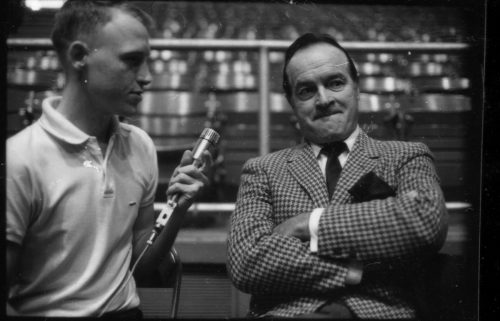
During Barto Farrar’s first interview — with Bob Hope — Farrar asked the star what it was like to have a Viet Cong bounty on his head. Photo courtesy of TCU Archives/Photo by Linda Kaye
Bob Hope was Farrar’s first interview. “It scared me to death,” Farrar said. The Bob Hope–Henry Mancini and Orchestra Show was part of TCU’s Homecoming festivities in October 1964. “When you’ve never done an interview or anything and here you’re interviewing Bob Hope — and then right after, Henry Mancini — I remember shaking quite a bit.”
Farrar’s cousin Warren Culbertson, one of the country’s first TV meteorologists to use radar, got him interested in broadcasting. Farrar’s family expected him to earn a college degree, but undecided on a major, he took classes in what is now called Film-TV-Digital Media.
Running the soundboard at the campus-based radio station, KTCU-FM, and acting as a disc jockey were part of the curriculum, but Farrar’s ambitions went beyond the booth. He created Backstage With the Stars, a 30-minute program. “I got the idea for a show, and nobody said, ‘No, don’t do that.’ So I just started doing it on the side,” he said. “It was just for the heck of it. I had the ability to do it, and I had a tape recorder, and away it went.”
An Ear for the Trends
In the 1960s, KTCU was a 10-watt radio station that broadcast easy-listening music and educational programs from 2 to 10 p.m.
“Most of the students were practicing to see if they had potential as DJs,” said Larry Lauer, a vice chancellor emeritus who started at TCU as a Radio-Television-Film faculty member and served as KTCU station manager in 1967. “They were trying to learn how to do commercial radio and whether or not they were talented enough or where they were talented [in radio].”
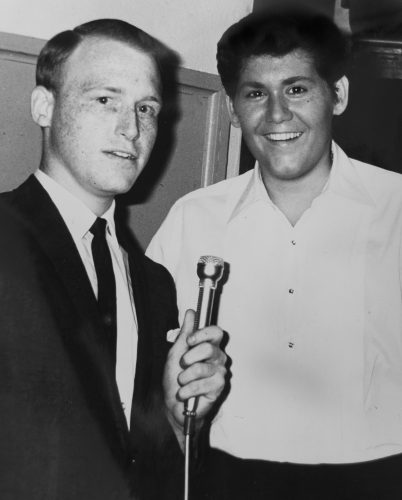
Barto Farrar often had his finger on the pulse of music and interviewed celebrities like Wayne Newton, pictured, and Hank Williams Jr. as their careers were budding. Photo courtesy of Barto Farrar
Living off campus and having a car gave Farrar an advantage. With a connection at Guys and Dolls Ballroom, he interviewed bandleaders such as Guy Lombardo, Harry James and Ray McKinley. “Of course with big bands that was their last dying hope with the Beatles and everything coming in,” Farrar said. “The big band sound went away.”
In the midst of the rock ’n’ roll crescendo in the late 1960s, Farrar interviewed country music stars Grandpa Jones, Lefty Frizzell, Claude King and Hank Williams Jr. “Lefty Frizzell had a tendency to drink. If you got him late in the evening, he was pretty happy,” Farrar said.
After Frizzell’s October 1965 performance at Will Rogers Auditorium in Fort Worth, Farrar sat down with the singer and mentioned his No. 1 hit “Saginaw, Michigan.” To the radio host’s surprise, Frizzell played the tune and Farrar aired the high-fidelity recording.
“[Frizzell] had his guitar and he sits there and he plays it for me,” Farrar said. “I listened to the tape later and you couldn’t tell it from the Columbia recording, except that I think he had a vocal group behind him in the Columbia recording. That was so weird. It was the only time I had anybody do live music while I was talking to them. That aired.”
To interview celebrities such as chart-topping Frizzell, Farrar had to get crafty sometimes. “I was pretty good at talking my way into places like Will Rogers.”
Farrar would go to the Fort Worth auditorium’s back door, show the security guard on duty his homemade KTCU press card and tell him who he was there to interview. “I could usually bluff my way in,” Farrar said. “[The guard] let me in the back where the dressing rooms are, and once I got into there, I was good.”
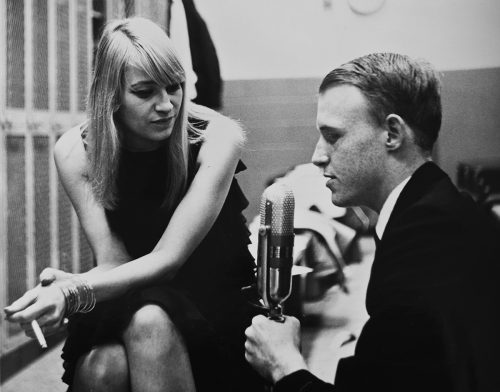
Mary Travers from the folk trio Peter, Paul and Mary talked with Barto Farrar for his KTCU program Backstage With the Stars. Photo courtesy of Barto Farrar
Some encounters with celebrities came with a fair share of adventure. When the folk group Peter, Paul and Mary landed at Dallas Love Field airport, Farrar was tasked with picking them up. He transported the trio — in a Lucas Funeral Home family procession car — to their concert venue.
“I remember going to Daniel-Meyer Coliseum,” Farrar said. “I was knocking on the back door and they said, ‘Go away! We’re waiting for Peter, Paul and Mary!’ And I said, ‘I’ve got them! Open the door!’ ”
The trio’s show and Farrar’s radio interview went off without a hitch. But the same could not be said about the following morning. The day after the group’s performance, they were set to perform their hit “Blowin’ in the Wind” during Farrar’s show on KTVT, a Fort Worth-based TV channel where radio-television-film students gained experience.
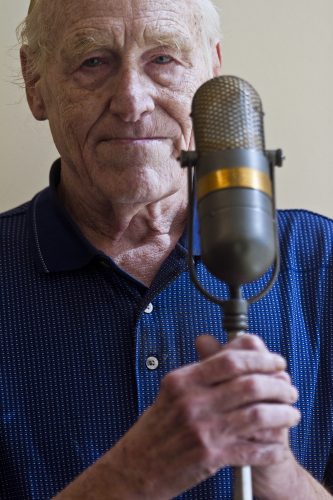
Barto Farrar would take his RCA microphone to meet stars in Fort Worth for KTCU. Photo by Mark Graham
Peter, Paul and Mary were still reeling from a night out with Carolyn Kynard ’67 and didn’t make it to the show. Farrar had to improvise with a couple of TCU professors.
Kynard and her friend Paula McClung were part of the security team guarding the famous trio against music groupies. Kynard also was friends with the group members from her time living in New York and working at the 1964 World’s Fair. “I was running around with Peter, Paul and Mary and drinking,” she said. “Back then we drank too much.”
Kynard, who was the continuity chief for KTCU for the 1966-67 school year, said she remembers Farrar. “He was super, super nice,” she said. “He was very dependable and that was rare. … He did what was necessary, and you could count on him to be there to support you or to get you whatever you needed.”
Serious Subjects
But Farrar’s time at KTCU wasn’t always about tracking stars. He was at the station when John F. Kennedy was assassinated in November 1963.
The station’s Associated Press wire typed out the news that the president was shot in Dallas. Alone in the station while everyone was out to lunch, Farrar found his classmates at the student center. “I said, ‘Kennedy’s been shot! We need to sign on!’ They kind of laughed, ‘Oh, you’re kidding.’ ”
Farrar went back to the station and signed on. Throughout the afternoon, the wire printed line after line. “They talk about ‘fake news’ now — they had a guy they arrested at Riverside and 28th Street in Fort Worth, and they said he was the guy who shot Kennedy. That was 30 minutes after Kennedy was shot,” Farrar said. “There’s no way anybody could drive over here. He’d have to be going 110 miles an hour. Everyone was running around like a chicken with its head cut off trying to figure it out.
“It was one of those times where a lot of stuff was happening, and you’re still almost a kid and you have no idea that you’re involved with that stuff,” Farrar said.
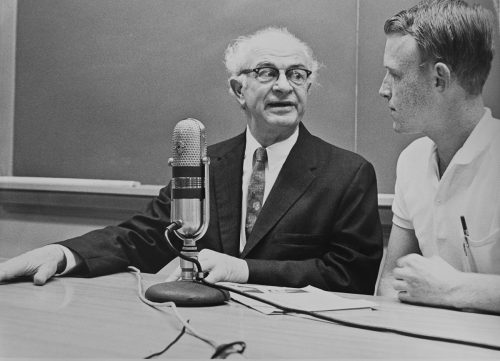
Two-time Nobel Prize-winning scientist Linus Pauling discussed the dangers of nuclear weapons with Barto Farrar in 1965. Photo courtesy of Barto Farrar
In 1963, the U.S., the United Kingdom and the Soviet Union signed the Limited Nuclear Test Ban Treaty. Linus Pauling organized an anti-test petition signed by more than 9,000 scientists, including Nobel Prize-winning physics icon Albert Einstein.
Two years after the treaty signing, Pauling visited Fort Worth and talked to Farrar about wanting a complete test-ban treaty to include underground testing and signed by all nations.
“I am encouraged by the general trend of the world in the direction of understanding the nature of nuclear weapons, the devastating capabilities that they have and the almost certain world destruction that would result if there were to be a nuclear war,” Pauling said during the 1965 interview. Pauling told Farrar that he believed “in the course of time we shall have disarmament and world peace — a world from which war has been eliminated.”
Ready for Anybody
When Farrar learned that Don Knotts was in Fort Worth to promote his new movie The Ghost and Mr. Chicken, he called the actor, who was better known for his TV work, in his hotel room and asked for an interview.
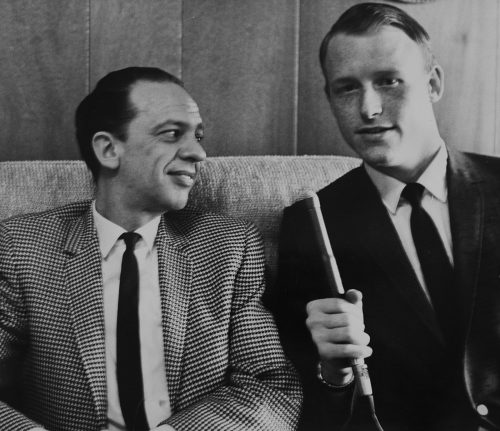
Don Knotts, in Fort Worth promoting The Ghost and Mr. Chicken in 1966, recalled his Emmy wins for his role as Barney Fife on The Andy Griffith Show and discussed strategies to memorize his lines. Photo courtesy of Barto Farrar.
Knotts spoke to Farrar as Barney Fife, the character the actor played on the TV hit The Andy Griffith Show. In that 1966 interview, Knotts discussed his character’s development, methods to memorize lines and what it was like to win an Emmy.
“I hadn’t even thought about it, when I got the first Emmy. It hadn’t even occurred that I would be up,” Knotts said, his voice more serious and a tad deeper than that of his well-known TV character. “I got three in a row there. I figured that was enough.” (Knotts won five Emmys for the show and earned a star on the Hollywood Walk of Fame in 2000.)
For other interviews, Farrar was at the right place at the right time, and he had a secret weapon: a suit.
Farrar heard, for example, that Mitch Miller, an executive at Columbia Records, was on campus. He grabbed his 35-pound tape recorder and changed clothes. “Since I was at the chancellor’s office with a suit on, I was almost like one of the dignitaries,” Farrar said. “I could get in.”
Editor’s Note: This story was reported before Barto Farrar died on March 6, 2018.

Your comments are welcome
Comments
Related reading:
Mem’ries Sweet, Web Extras
TCU Magazine Podcast: Barto Farrar
The KTCU host often had his finger on the pulse of music and entertainment as he interviewed dozens of celebrities.
Features
KTCU Celebrates 70 Years
The campus radio station offers students a chance for real-world experience.
Alumni
Krys Boyd Gives Listeners Something to ‘Think’ About
The host of KERA’s Think radio show brings her unique journalistic style to a wide range of interviews.